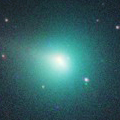
|
Now it is bright as 9.6 mag (Feb. 20, Osamu Miyazaki). It stays bright as 9-10 mag until March. In the Northern Hemisphere, it stays observable in excellent condition for a long time. In the Southern Hemisphere, it stays extremely low after this.
Date(TT) R.A. (2000) Decl. Delta r Elong. m1 Best Time(A, h)
Feb. 19 2 12.34 16 29.5 1.358 1.323 66 9.2 19:10 ( 76, 47)
Feb. 26 2 32.09 20 49.0 1.403 1.338 65 9.4 19:16 ( 84, 47)
|
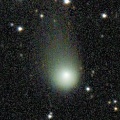
|
Now it is bright as 11.1 mag (Feb. 11, Osamu Miyazaki). It is expected to be observable at 5-6 mag for a long time from 2022 to 2023. In the Northern Hemisphere, it stays observable in good condition until autumn. However, it is not observable at the high light from autumn to 2023 summer. In the Southern Hemisphere, it is appearing in the morning sky. It stays observable in good condition after this.
Date(TT) R.A. (2000) Decl. Delta r Elong. m1 Best Time(A, h)
Feb. 19 18 35.01 11 21.2 4.394 3.955 57 10.2 5:17 (284, 38)
Feb. 26 18 39.46 11 18.9 4.257 3.891 61 10.0 5:09 (287, 41)
|
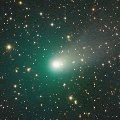
|
Now it is 9.8 mag (Feb. 20, Osamu Miyazaki). It stays bright as 10 mag until spring for a long time. It stays observable in good condition for a long time. It locates somewhat low in the Southern Hemisphere,
Date(TT) R.A. (2000) Decl. Delta r Elong. m1 Best Time(A, h)
Feb. 19 6 35.82 23 12.2 2.877 3.574 128 10.1 20:39 ( 0, 78)
Feb. 26 6 34.56 21 55.3 2.969 3.581 120 10.2 20:10 ( 0, 77)
|
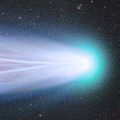
|
It brightened up to 3 mag from mid December to late December. Now it is fading. It faded down to 8.5 mag in late January (Jan. 28, Chris Wyatt). In the Southern Hemisphere, it becames unobservable temporarily in early February. But it is appearing in the morning sky. In the Northern Hemisphere, it will become observable again at 13 mag in late April.
Date(TT) R.A. (2000) Decl. Delta r Elong. m1 Best Time(A, h)
Feb. 19 21 26.98 -35 11.8 1.943 1.134 25 10.5 5:17 (298,-22)
Feb. 26 21 24.30 -34 59.4 1.987 1.243 30 10.9 5:09 (300,-18)
|
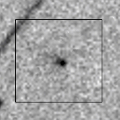
|
Now it is 12.7 mag (Feb. 4, Thomas Lehmann). In the Northern Hemisphere, it stays extremely low until spring. In the Southern Hemisphere, it stays observable at 11 mag until June.
Date(TT) R.A. (2000) Decl. Delta r Elong. m1 Best Time(A, h)
Feb. 19 19 27.42 -20 0.4 2.208 1.577 39 11.2 5:17 (301, 8)
Feb. 26 19 50.19 -19 18.3 2.169 1.566 41 11.1 5:09 (300, 8)
|
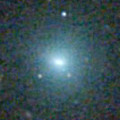
|
Brightened very rapidly. Now it is very bright as 10.4 mag (Feb. 20, Osamu Miyazaki). It will be fading after this.
Date(TT) R.A. (2000) Decl. Delta r Elong. m1 Best Time(A, h)
Feb. 19 3 54.86 10 9.6 0.683 1.189 88 11.4 19:10 ( 37, 61)
Feb. 26 4 30.40 11 58.3 0.719 1.231 90 12.0 19:16 ( 38, 62)
|
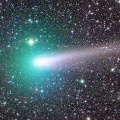
|
It brightened up to 8.5 mag from autumn to winter (Dec. 2, Toshihiko Ikemura, Hirohisa Sato). Now it is fading. But it is still bright as 11.5 mag (Feb. 20, Osamu Miyazaki). It stays observable in good condition for a long time. It locates somewhat low in the Southern Hemisphere,
Date(TT) R.A. (2000) Decl. Delta r Elong. m1 Best Time(A, h)
Feb. 19 8 22.77 27 39.5 0.840 1.768 150 11.5 22:26 ( 0, 83)
Feb. 26 8 22.84 27 1.1 0.927 1.823 143 11.9 21:58 ( 0, 82)
|
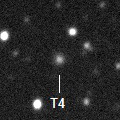
|
Now it is 12.7 mag (Feb. 9, Chris Wyatt). It will brighten up to 11.5 mag in spring. It stas observable in good condition for a long time.
Date(TT) R.A. (2000) Decl. Delta r Elong. m1 Best Time(A, h)
Feb. 19 12 6.14 -28 10.8 3.625 4.340 131 11.8 2:12 ( 0, 27)
Feb. 26 12 4.29 -27 24.9 3.544 4.328 137 11.7 1:43 ( 0, 27)
|
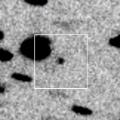
|
Now it is 14.7 mag (Feb. 3, Giuseppe Pappa). It stays 12-13 mag for a while. But actually, it is fainter than this ephemeris recently.
Date(TT) R.A. (2000) Decl. Delta r Elong. m1 Best Time(A, h)
Feb. 19 18 9.18 -21 58.5 1.830 1.550 57 12.2 5:17 (317, 19)
Feb. 26 18 31.78 -22 26.7 1.787 1.546 59 12.2 5:09 (316, 18)
|
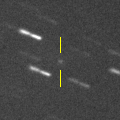
|
Now it is bright as 12.4 mag (Feb. 6, Ken-ichi Kadota). It stays 13 mag until spring. In the Northern Hemisphere, it is observable only until early March. In the Southern Hemisphere, it is not observable until late May. But it will be observable in good condition after that.
Date(TT) R.A. (2000) Decl. Delta r Elong. m1 Best Time(A, h)
Feb. 19 21 21.80 48 1.5 1.423 1.270 60 12.8 5:17 (227, 24)
Feb. 26 22 15.97 45 36.5 1.462 1.202 54 12.6 5:09 (226, 18)
|
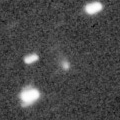
|
Now it is 15.1 mag (Feb. 1, Ken-ichi Kadota). It is expected to brighten very rapidly up to 4.5 mag in April. However, it is not observable at the high light. In the Northern Hemisphere, it will appear at 6 mag in mid May, and it stays observable in good condition after that while the comet will be fading. In the Southern Hemisphere, it is not observable until August.
Date(TT) R.A. (2000) Decl. Delta r Elong. m1 Best Time(A, h)
Feb. 19 23 20.36 0 2.5 2.349 1.472 21 13.5 19:10 ( 88, 3)
Feb. 26 23 33.84 -0 9.4 2.259 1.344 17 13.1 19:16 ( 91, -1)
|

|
Now it is 15.8 mag (Jan. 18, J. Drummond). It will brighten up to 13 mag in spring. In the Southern Hemisphere, it stays observable in good condition for a long time. In the Northern Hemisphere, it is not observable until autumn.
Date(TT) R.A. (2000) Decl. Delta r Elong. m1 Best Time(A, h)
Feb. 19 10 39.66 -69 38.8 3.040 3.335 98 13.6 0:47 ( 0,-15)
Feb. 26 9 56.49 -70 24.0 2.988 3.313 100 13.6 23:27 ( 0,-16)
|

|
Now it is bright as 11.1 mag (Jan. 24, Charles S. Morris). It has a large diffuse coma.
Date(TT) R.A. (2000) Decl. Delta r Elong. m1 Best Time(A, h)
Feb. 19 4 17.57 29 28.3 5.748 5.959 97 13.6 19:10 ( 65, 78)
Feb. 26 4 19.45 29 20.5 5.862 5.961 90 13.7 19:16 ( 77, 72)
|
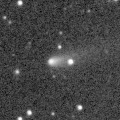
|
Now it is 13.8 mag (Feb. 11, Charles S. Morris). It is observable at 13.5 mag in good condition until spring.
Date(TT) R.A. (2000) Decl. Delta r Elong. m1 Best Time(A, h)
Feb. 19 9 44.65 18 52.7 1.442 2.422 170 13.9 23:47 ( 0, 74)
Feb. 26 9 38.93 19 11.0 1.439 2.403 162 13.8 23:14 ( 0, 74)
|
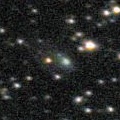
|
Now it is 14.9 mag (Nov. 28, Thomas Lehmann). It is expected to brighten up to 11 mag from spring to summer. In the Southen Hemisphere, it is appearing in the morning sky. It stays observable in good condition for a long time after this. In the Northern Hemisphere, it is hardly observable after this.
Date(TT) R.A. (2000) Decl. Delta r Elong. m1 Best Time(A, h)
Feb. 19 20 3.90 -15 29.8 3.073 2.277 30 14.0 5:17 (292, 4)
Feb. 26 20 11.24 -16 51.3 2.950 2.225 35 13.8 5:09 (295, 6)
|
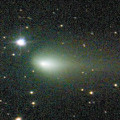
|
It brightened up to 10.6 mag in autumn (Oct. 10, Osamu Miyazaki). Now it is fading. It has already faded down to 12.8 mag (Feb. 11, Charles S. Morris). It stays observable in good condition for a long time.
Date(TT) R.A. (2000) Decl. Delta r Elong. m1 Best Time(A, h)
Feb. 19 6 24.53 11 51.7 1.539 2.259 125 13.9 20:28 ( 0, 67)
Feb. 26 6 28.53 12 29.0 1.647 2.301 119 14.2 20:04 ( 0, 68)
|

|
It brightened up to 12.3 mag from spring to summer (June 15, Marco Goiato). Now it is fading. It has already faded down to 14.1 mag (Feb. 9, Chris Wyatt).
Date(TT) R.A. (2000) Decl. Delta r Elong. m1 Best Time(A, h)
Feb. 19 14 12.29 15 7.5 3.785 4.373 120 14.0 4:18 ( 0, 70)
Feb. 26 14 6.01 17 5.6 3.732 4.413 128 14.1 3:44 ( 0, 72)
|
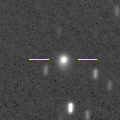
|
Now it is 13.9 mag (Feb. 10, Toshihiko Ikemura, Hirohisa Sato). It is expected to brighten up to 10 mag in 2023. In the Northern Hemisphere, it stays observable in good condition until 2023 autumn. In the Southern Hemipshere, it stays unobservable until 2023 summer.
Date(TT) R.A. (2000) Decl. Delta r Elong. m1 Best Time(A, h)
Feb. 19 12 43.49 53 21.8 4.432 5.100 127 14.3 2:50 (180, 72)
Feb. 26 12 34.26 55 7.0 4.372 5.044 128 14.2 2:13 (180, 70)
|
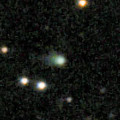
|
Now it is 14.4 mag (Feb. 8, Toshihiko Ikemura, Hirohisa Sato). It is expected to brighten up to 11 mag in 2023. In the Northern Hemisphere, it stays observable in good condition for a long time. It is not observable in the Southern Hemisphere.
Date(TT) R.A. (2000) Decl. Delta r Elong. m1 Best Time(A, h)
Feb. 19 16 41.60 34 49.2 4.965 5.060 89 14.5 5:17 (264, 72)
Feb. 26 16 39.63 35 45.4 4.848 5.020 94 14.4 5:09 (262, 76)
|

|
Now it is 15.3 mag (Feb. 3, Thomas Lehmann). Appearing in the morning. It will brighten up to 13 mag in summer.
Date(TT) R.A. (2000) Decl. Delta r Elong. m1 Best Time(A, h)
Feb. 19 17 56.71 -25 22.9 3.477 3.116 60 14.6 5:17 (321, 18)
Feb. 26 18 6.35 -25 36.8 3.384 3.109 65 14.5 5:09 (323, 19)
|

|
Now it is 15.7 mag (Feb. 2, Thomas Lehmann). It will brighten up to 12.5 mag in summer. In the Southern Hemisphere, it stays observable in excellent condition for a long time, although it becomes low temporarily in February. In the Northern Hemisphere, it is not observable until August.
Date(TT) R.A. (2000) Decl. Delta r Elong. m1 Best Time(A, h)
Feb. 19 22 30.84 -56 42.1 4.224 3.600 45 14.7 19:10 ( 41,-33)
Feb. 26 22 33.96 -55 56.1 4.163 3.563 47 14.6 5:09 (318,-37)
|
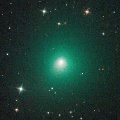
|
It brightened up to 9.5 mag in early summer (June 27, Marco Goiato). Now it is fading. It has faded down to 12.7 mag in autumn (Nov. 22, Thomas Lehmann). Now it is not observable. In the Southern Hemisphere, it is appearing in the morning sky. In the Northern Hemisphere, it is not observable until June when the comet will fade down to 17 mag.
Date(TT) R.A. (2000) Decl. Delta r Elong. m1 Best Time(A, h)
Feb. 19 21 13.33 -32 3.1 4.139 3.262 24 15.1 5:17 (297,-18)
Feb. 26 21 25.11 -31 47.2 4.161 3.320 28 15.3 5:09 (298,-16)
|

|
Now it is 16.0 mag (Feb. 3, Thomas Lehmann). It stays at 15-16 mag for a long time. In the Southern Hemisphere, it stays observable in excellent condition for a long time. In the Northern Hemiphere, it locates extremely low in spring.
Date(TT) R.A. (2000) Decl. Delta r Elong. m1 Best Time(A, h)
Feb. 19 17 20.52 -35 35.3 5.335 5.061 68 15.2 5:17 (333, 13)
Feb. 26 17 21.09 -36 39.7 5.227 5.071 75 15.1 5:09 (338, 14)
|
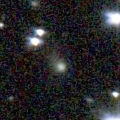
|
Now it is 15.4 mag (Feb. 11, Toshihiko Ikemura, Hirohisa Sato). It is expected to brighten up to 11 mag in 2023. In the Northern Hemisphere, it stays observable in good condition until November. But it becomes unobservable after that. In the Southern Hemisphere, it is appearing in the morning sky. It stays observable in good condition after this.
Date(TT) R.A. (2000) Decl. Delta r Elong. m1 Best Time(A, h)
Feb. 19 18 48.00 17 18.7 5.603 5.136 57 15.3 5:17 (276, 39)
Feb. 26 18 51.54 17 21.7 5.492 5.089 61 15.2 5:09 (278, 42)
|
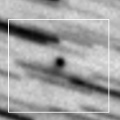
|
Now it is 15.0 mag (Feb. 4, J.-G. Bosch, F. Kugel, A. Klotz, J. Nicolas). It is expected to brighten up to 11 mag in summer. In the Northern Hemisphere, it stays observable in good condition until June when it brightens up to 11 mag. But it is not observable after the high light. In the Souther Hemisphere, it is not observable until October.
Date(TT) R.A. (2000) Decl. Delta r Elong. m1 Best Time(A, h)
Feb. 19 23 40.37 51 28.8 2.842 2.602 66 15.4 19:10 (134, 32)
Feb. 26 23 53.84 51 59.7 2.808 2.522 63 15.3 19:16 (136, 29)
|
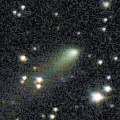
|
Now it is 15.4 mag (Feb. 6, Ken-ichi Kadota). It will be fading after this. In the Northern Hemisphere, it stays observable in good condition for a long time. It locates low in the Southern Hemisphere.
Date(TT) R.A. (2000) Decl. Delta r Elong. m1 Best Time(A, h)
Feb. 19 15 40.28 32 56.6 2.408 2.787 102 15.5 5:17 (288, 84)
Feb. 26 15 27.05 35 34.1 2.348 2.829 108 15.6 5:05 (180, 90)
|
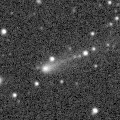
|
It brightened rapidly. Now it is 15.0 mag (Feb. 16, Ken-ichi Kadota). It stays 15 mag until February, and it is observable in excellent condition.
Date(TT) R.A. (2000) Decl. Delta r Elong. m1 Best Time(A, h)
Feb. 19 7 54.89 13 48.6 1.681 2.570 147 15.7 21:58 ( 0, 69)
Feb. 26 7 52.42 13 37.3 1.745 2.582 139 15.8 21:28 ( 0, 69)
|
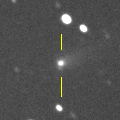
|
Now it is 15.8 mag (Feb. 8, Toshihiko Ikemura, Hirohisa Sato). It stays 15.5 mag until March, and it is observable in excellent condition.
Date(TT) R.A. (2000) Decl. Delta r Elong. m1 Best Time(A, h)
Feb. 19 11 50.84 9 46.7 1.253 2.188 154 15.7 1:57 ( 0, 65)
Feb. 26 11 47.35 10 40.2 1.247 2.210 162 15.7 1:26 ( 0, 66)
|
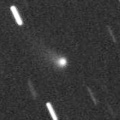
|
Now it is 14.5 mag (Feb. 8, Toshihiko Ikemura, Hirohisa Sato). It stays observable at 15 mag for a long time.
Date(TT) R.A. (2000) Decl. Delta r Elong. m1 Best Time(A, h)
Feb. 19 12 24.67 11 9.8 2.631 3.498 146 15.8 2:31 ( 0, 66)
Feb. 26 12 12.29 10 44.3 2.606 3.533 155 15.8 1:51 ( 0, 66)
|
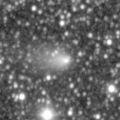
|
It brightened up to 11.5 mag in outburst in October (Oct. 22, Marco Goiato). Now it is fading. It has already faded down to 15.1 mag (Jan. 24, A. Diepvens). But Hiroshi Abe reported it is bright as 12.3 mag on Jan. 22. In the Southern Hemisphere, it is already unobservable. In the Northern Hemisphere, it stays observable until early February.
Date(TT) R.A. (2000) Decl. Delta r Elong. m1 Best Time(A, h)
Feb. 19 23 31.78 -2 49.7 2.931 2.052 22 15.8 19:10 ( 84, 4)
Feb. 26 23 46.91 -1 17.8 2.992 2.084 19 16.1 19:16 ( 88, 1)
|
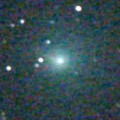
|
It brightened up to 9.8 mag from autumn to winter (Nov. 22, Thomas Lehmann). Now it is fading. It has already faded down to 16.0 mag (Feb. 11, Charles S. Morris). It will be fainter than 18 mag in March.
Date(TT) R.A. (2000) Decl. Delta r Elong. m1 Best Time(A, h)
Feb. 19 1 43.34 -6 29.8 2.565 2.126 53 16.1 19:10 ( 60, 27)
Feb. 26 1 56.97 -4 53.3 2.672 2.176 50 16.7 19:16 ( 65, 24)
|
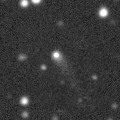
|
Now it is 16.0 mag (Feb. 11, Toshihiko Ikemura, Hirohisa Sato). It stays observable at 16 mag from 2021 to 2022.
Date(TT) R.A. (2000) Decl. Delta r Elong. m1 Best Time(A, h)
Feb. 19 16 14.67 19 28.8 4.691 4.833 92 16.1 5:17 (314, 69)
Feb. 26 16 17.19 21 13.7 4.619 4.846 97 16.1 5:09 (321, 73)
|
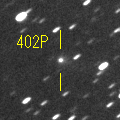
|
First return of a new periodic comet observed at 16 mag from 2003 to 2004. Now it is 16.3 mag (Feb. 17, Ken-ichi Kadota). It stays 16 mag until March, and it stays observable in excellent condition.
Date(TT) R.A. (2000) Decl. Delta r Elong. m1 Best Time(A, h)
Feb. 19 6 0.37 9 43.9 3.380 3.956 119 16.1 20:04 ( 0, 65)
Feb. 26 6 0.94 10 40.5 3.473 3.960 112 16.2 19:37 ( 0, 66)
|
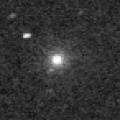
|
Now it is 18.7 mag (Feb. 13, Giuseppe Pappa). It was observed at 9-10 mag from late July to early August. Although it had been unobservable for a long time, it is appearing in the morning sky now.
Date(TT) R.A. (2000) Decl. Delta r Elong. m1 Best Time(A, h)
Feb. 19 16 38.58 -28 8.7 3.078 3.032 78 16.3 5:17 (339, 24)
Feb. 26 16 41.22 -28 52.3 3.052 3.115 84 16.4 5:09 (343, 24)
|
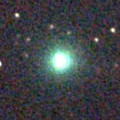
|
It brightened very rapidly, and brightened up to 8.9 mag (Sept. 11, Chris Wyatt). Now it is fading. It has already faded down to 18.5 mag (Feb. 11, J. L. Virlichie, P. Traverse, H. Roy). In the Southern Hemisphere, it stays observable after this while the comet will be fading. It is not observable after this in the Northern Hemisphere.
Date(TT) R.A. (2000) Decl. Delta r Elong. m1 Best Time(A, h)
Feb. 19 17 38.45 -55 12.5 2.721 2.520 67 16.3 5:17 (340, -6)
Feb. 26 17 46.58 -55 26.6 2.706 2.588 72 16.6 5:09 (341, -5)
|

|
Now it is 16.2 mag (Jan. 27, SONEAR Observatory, Oliveira). It will be fading slowly after this. In the Southern Hemisphere, it stays observable in good condition for a long time, although it becomes extremely low temporarily from March to April. In the Northern Hemisphere, it is not observable until July.
Date(TT) R.A. (2000) Decl. Delta r Elong. m1 Best Time(A, h)
Feb. 19 0 13.68 -41 37.6 4.894 4.195 40 16.3 19:10 ( 47,-12)
Feb. 26 0 22.15 -40 2.2 4.947 4.227 39 16.4 19:16 ( 51,-15)
|

|
Brightened rapidly. Now it is 16.1 mag (Jan. 29, ATLAS-MLO, Mauna Loa). It is observable at 15.5-16 mag in good condition in winter.
Date(TT) R.A. (2000) Decl. Delta r Elong. m1 Best Time(A, h)
Feb. 19 2 35.01 12 18.2 4.059 3.840 70 16.5 19:10 ( 66, 49)
Feb. 26 2 41.52 12 38.8 4.161 3.847 64 16.6 19:16 ( 72, 44)
|
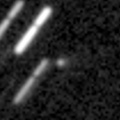
|
Now it is 17.7 mag (Feb. 4, J.-G. Bosch, F. Kugel, A. Klotz, J. Nicolas). It is expected to brighten up to 11 mag from summer to autumn. It stays observable in good condition in the Southern Hemisphere. In the Northern Hemisphere, it becomes extremely low from August to September.
Date(TT) R.A. (2000) Decl. Delta r Elong. m1 Best Time(A, h)
Feb. 19 10 45.78 28 3.0 1.452 2.409 161 16.8 0:53 ( 0, 83)
Feb. 26 10 36.62 29 16.9 1.398 2.351 159 16.6 0:16 ( 0, 84)
|
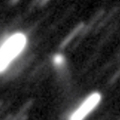
|
Now it is 16.6 mag (Feb. 11, D. Buczynski). It was observed at 15 mag in 2021. Now it is fading. It stays observable at 17 mag for a while in 2022.
Date(TT) R.A. (2000) Decl. Delta r Elong. m1 Best Time(A, h)
Feb. 19 18 29.43 4 31.0 5.522 5.048 56 16.6 5:17 (292, 35)
Feb. 26 18 33.43 5 46.2 5.452 5.063 61 16.6 5:09 (294, 39)
|

|
It has not been observed yet in this apparition. It was expected to be observable at 16 mag in good condition in spring. But actually, it is fainter than 19.2 mag (Jan. 22, John Drummond).
Date(TT) R.A. (2000) Decl. Delta r Elong. m1 Best Time(A, h)
Feb. 19 16 53.25 -34 36.1 1.417 1.493 74 16.9 5:17 (338, 16)
Feb. 26 17 20.19 -34 18.1 1.362 1.473 75 16.7 5:09 (337, 16)
|
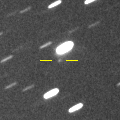
|
Now it is 15.2 mag (Feb. 16, Ken-ichi Kadota). It is observable at 16 mag in good condition from winter to spring. It is brighter than this ephemeris recently.
Date(TT) R.A. (2000) Decl. Delta r Elong. m1 Best Time(A, h)
Feb. 19 10 19.65 -21 47.2 1.489 2.378 146 16.7 0:26 ( 0, 33)
Feb. 26 10 18.53 -19 18.4 1.470 2.387 151 16.7 23:53 ( 0, 36)
|
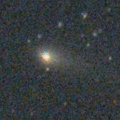
|
It brightened up to 13.1 mag in autumn (Oct. 28, Toshihiko Ikemura, Hirohisa Sato). Now it is fading. But it is still bright as 15.8 mag (Feb. 17, Ken-ichi Kadota). It stays observable in good condition for a long time.
Date(TT) R.A. (2000) Decl. Delta r Elong. m1 Best Time(A, h)
Feb. 19 3 16.25 12 17.9 1.851 1.941 80 16.7 19:10 ( 54, 57)
Feb. 26 3 31.16 13 25.9 1.948 1.973 76 17.0 19:16 ( 61, 54)
|
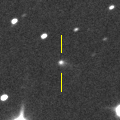
|
Now it is 16.9 mag (Jan. 31, Toshihiko Ikemura, Hirohisa Sato). It will brighten up to 14 mag in early 2023. It stays observable in good condition until spring.
Date(TT) R.A. (2000) Decl. Delta r Elong. m1 Best Time(A, h)
Feb. 19 4 20.50 6 57.0 4.484 4.663 94 16.7 19:10 ( 23, 60)
Feb. 26 4 22.69 7 36.7 4.547 4.622 88 16.7 19:16 ( 38, 57)
|

|
Now it is 17.2 mag (Jan. 18, J. Drummond). It brightened rapidly. It stays 17 mag for a long time from 2021 to 2022. In the Southern Hemisphere, it stays observable in good condition for a long time. In the Northern Hemisphere, it will be observable only in extremely low sky from autumn to winter.
Date(TT) R.A. (2000) Decl. Delta r Elong. m1 Best Time(A, h)
Feb. 19 7 18.73 -47 4.1 4.957 5.380 110 16.7 21:20 ( 0, 8)
Feb. 26 7 10.26 -46 44.9 4.997 5.388 108 16.8 20:45 ( 0, 8)
|
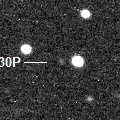
|
Now it is 18.6 mag (Feb. 12, Palomar Mountain--ZTF). It was expected to brighten up to 16.5-17 mag in winter. In its last apparition in 2015, it brightened up to 13 mag. But actually, it is fainter than this ephemeris recently.
Date(TT) R.A. (2000) Decl. Delta r Elong. m1 Best Time(A, h)
Feb. 19 1 16.19 -3 19.6 2.092 1.595 47 16.8 19:10 ( 67, 24)
Feb. 26 1 33.99 -0 52.2 2.116 1.584 45 16.8 19:16 ( 72, 23)
|
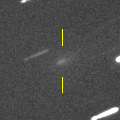
|
First return of a new periodic comet which brightened up to 17 mag in 2011. Now it is extremely faint as 20.4 mag (Feb. 4, J.-G. Bosch, F. Kugel, A. Klotz, J. Nicolas). It brightened up to 16.8 mag in October (Oct. 10, Ken-ichi Kadota), however, it has been fading after that.
Date(TT) R.A. (2000) Decl. Delta r Elong. m1 Best Time(A, h)
Feb. 19 15 11.12 -13 39.7 1.243 1.728 100 16.8 5:17 ( 0, 41)
Feb. 26 15 19.37 -14 20.0 1.206 1.757 105 16.9 4:57 ( 0, 41)
|

|
Now it is 16.9 mag (Jan. 8, Toshihiko Ikemura, Hirohisa Sato). Fading slowly. In the Northern Hemisphere, it stays observable in good condition for a long time. In the Southern Hemisphere, it is not observable after this.
Date(TT) R.A. (2000) Decl. Delta r Elong. m1 Best Time(A, h)
Feb. 19 19 13.92 51 57.9 9.274 9.046 73 16.9 5:17 (229, 44)
Feb. 26 19 16.77 52 50.2 9.266 9.055 74 16.9 5:09 (227, 47)
|
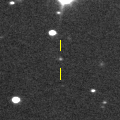
|
Now it is 16.6 mag (Jan. 29, Observatoire Chante-Perdrix, Dauban). It will brighten up to 11.5 mag in 2022 winter. It stays observable while the comet will be brightening slowly.
Date(TT) R.A. (2000) Decl. Delta r Elong. m1 Best Time(A, h)
Feb. 19 3 10.19 14 38.9 3.025 3.000 79 17.0 19:10 ( 60, 57)
Feb. 26 3 15.63 15 8.2 3.086 2.961 73 16.9 19:16 ( 68, 52)
|
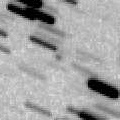
|
Now it is 17.8 mag (Jan. 2, Ken-ichi Kadota). It is expected to brighten up to 13.5 mag from June to July. It is observable only in the Southern Hemisphere at the high light. In the Northern Hemisphere, it is observable only until March when it brightens up to 16.5 mag.
Date(TT) R.A. (2000) Decl. Delta r Elong. m1 Best Time(A, h)
Feb. 19 1 15.39 2 31.8 2.536 2.022 48 17.1 19:10 ( 72, 28)
Feb. 26 1 18.93 1 9.3 2.567 1.948 42 16.9 19:16 ( 76, 21)
|
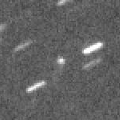
|
Now it is 16.6 mag (Jan. 31, Ken-ichi Kadota). It started fading before the perihelion passage. It was predicted to stay at 16 mag for a long time, but actually, it will be fainter than 18 mag in autumn. In the Northern Hemisphere, it stays observable in good condition for a long time. In the Southern Hemisphere, it is not observable until 2023.
Date(TT) R.A. (2000) Decl. Delta r Elong. m1 Best Time(A, h)
Feb. 19 23 19.81 78 10.2 3.670 3.804 90 17.0 19:10 (166, 35)
Feb. 26 23 28.33 77 5.5 3.727 3.795 86 17.1 19:16 (165, 33)
|
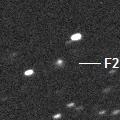
|
Now it is 17.0 mag (Feb. 11, Toshihiko Ikemura, Hirohisa Sato). It stays observable at 17-18 mag for a long time until 2024.
Date(TT) R.A. (2000) Decl. Delta r Elong. m1 Best Time(A, h)
Feb. 19 14 32.71 -3 16.4 8.430 8.858 112 17.1 4:38 ( 0, 52)
Feb. 26 14 30.19 -2 48.5 8.314 8.854 120 17.0 4:08 ( 0, 52)
|
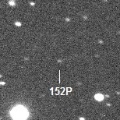
|
It will brighten up to 16 mag from spring to summer. It locates somewhat low in the Northern Hemisphere.
Date(TT) R.A. (2000) Decl. Delta r Elong. m1 Best Time(A, h)
Feb. 19 18 34.46 -21 56.7 3.610 3.101 52 17.1 5:17 (312, 15)
Feb. 26 18 44.57 -21 58.3 3.535 3.104 56 17.1 5:09 (314, 17)
|
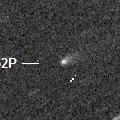
|
It brightened up to 16.4 mag from autumn to winter (Oct. 6, ATLAS-MLO, Mauna Loa). Now it is fading. It has already faded down to 17.9 mag (Feb. 11, Toshihiko Ikemura, Hirohisa Sato).
Date(TT) R.A. (2000) Decl. Delta r Elong. m1 Best Time(A, h)
Feb. 19 12 53.12 -11 55.0 1.377 2.174 132 17.1 2:59 ( 0, 43)
Feb. 26 12 49.76 -12 28.2 1.354 2.208 140 17.2 2:28 ( 0, 42)
|
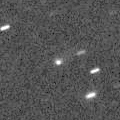
|
Now it is 17.3 mag (Feb. 11, Toshihiko Ikemura, Hirohisa Sato). It will be observable at 17 mag in good condition in spring.
Date(TT) R.A. (2000) Decl. Delta r Elong. m1 Best Time(A, h)
Feb. 19 13 44.00 -9 46.3 4.107 4.710 122 17.2 3:50 ( 0, 45)
Feb. 26 13 43.42 -9 45.9 4.017 4.709 129 17.2 3:22 ( 0, 45)
|
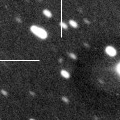
|
Now it is 16.8 mag (Feb. 11, ATLAS Chile, Rio Hurtado). It will brighten up to 13-14 mag from 2024 to 2025.
Date(TT) R.A. (2000) Decl. Delta r Elong. m1 Best Time(A, h)
Feb. 19 7 13.00 -30 55.6 7.874 8.416 120 17.2 21:16 ( 0, 24)
Feb. 26 7 11.46 -30 31.0 7.879 8.379 117 17.2 20:46 ( 0, 24)
|
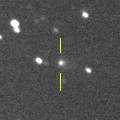
|
Now it is 17.0 mag (Jan. 29, ATLAS-MLO, Mauna Loa). It continued brightening for a while even after the perihelion passage. It stays observable at 16-17 mag in good condition for a while.
Date(TT) R.A. (2000) Decl. Delta r Elong. m1 Best Time(A, h)
Feb. 19 4 25.77 -6 3.4 3.871 4.046 93 17.2 19:10 ( 15, 48)
Feb. 26 4 28.47 -4 54.8 3.984 4.065 87 17.3 19:16 ( 27, 47)
|
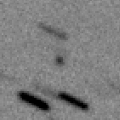
|
Now it is 17.8 mag (Jan. 31, Ken-ichi Kadota). It is observable at 17 mag from November to March. It is observable in good condition in the Northern Hemisphere, but it locates low in the Southern Hemisphere.
Date(TT) R.A. (2000) Decl. Delta r Elong. m1 Best Time(A, h)
Feb. 19 5 24.82 31 16.8 1.930 2.478 112 17.4 19:29 ( 0, 86)
Feb. 26 5 29.71 31 40.2 2.004 2.472 106 17.4 19:16 ( 33, 86)
|
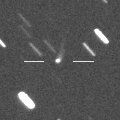
|
Now it is 18.4 mag (Jan. 9, J. Drummond). In the Southern Hemisphere, it stays observable for a long time. In the Northern Hemisphere, it is not observable after this.
Date(TT) R.A. (2000) Decl. Delta r Elong. m1 Best Time(A, h)
Feb. 19 10 38.94 -51 38.4 3.504 4.044 116 17.4 0:46 ( 0, 3)
Feb. 26 10 27.11 -50 7.4 3.496 4.094 120 17.5 0:06 ( 0, 5)
|

|
Now it is 17.8 mag (Jan. 8, Toshihiko Ikemura, Hirohisa Sato). It stays 17-18 mag for a long time from 2021 to 2022. It is observable in excellent condition in the Northern Hemisphere, It locates somewhat low in the Southern Hemisphere.
Date(TT) R.A. (2000) Decl. Delta r Elong. m1 Best Time(A, h)
Feb. 19 2 39.28 27 25.3 5.514 5.366 76 17.5 19:10 ( 87, 58)
Feb. 26 2 37.91 27 7.6 5.638 5.362 68 17.6 19:16 ( 92, 51)
|

|
Now it is 17.0 mag (Jan. 26, ATLAS-HKO, Haleakala). In the Northern Hemisphere, it stays observable for a long time while it is getting fainter slowly. In the Southern Hemisphere, it will never be observable again.
Date(TT) R.A. (2000) Decl. Delta r Elong. m1 Best Time(A, h)
Feb. 19 14 51.10 44 40.1 7.370 7.791 111 17.6 4:56 (180, 80)
Feb. 26 14 48.77 45 12.4 7.369 7.838 114 17.6 4:27 (180, 80)
|
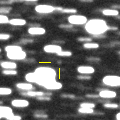
|
Now it is 17.4 mag (Jan. 29, Toshihiko Ikemura, Hirohisa Sato). It will brighten up to 15-16 mag in 2023.
Date(TT) R.A. (2000) Decl. Delta r Elong. m1 Best Time(A, h)
Feb. 19 6 53.20 -22 4.6 4.708 5.293 121 17.6 20:55 ( 0, 33)
Feb. 26 6 45.89 -21 12.2 4.734 5.247 116 17.6 20:21 ( 0, 34)
|
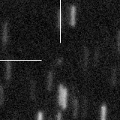
|
Now it is 18.5 mag (Jan. 24, A. Diepvens). It is expected to brighten up to 12 mag from winter to summer in 2023. In the Northern Hemisphere, it stays observable in good condition until 2023 spring. In the Southern Hemisphere, it is not observable until summer.
Date(TT) R.A. (2000) Decl. Delta r Elong. m1 Best Time(A, h)
Feb. 19 1 44.33 46 54.1 5.222 5.067 75 17.6 19:10 (124, 51)
Feb. 26 1 50.06 46 3.0 5.258 5.009 70 17.6 19:16 (123, 46)
|
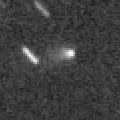
|
Now it is 16.5 mag (Jan. 26, Ken-ichi Kadota). It was expected to brighten up to 15.5 mag in winter. But actually, it is fading even before the perihelion passage. In the Northern Hemisphere, it stays observable in good condition for a long time. It is not observable at all in the Southern Hemisphere.
Date(TT) R.A. (2000) Decl. Delta r Elong. m1 Best Time(A, h)
Feb. 19 6 43.14 86 17.8 2.554 2.950 103 17.6 20:49 (180, 39)
Feb. 26 6 17.71 82 24.4 2.583 2.955 102 17.7 19:56 (180, 43)
|
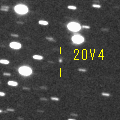
|
Now it is 16.9 mag (Jan. 31, ATLAS-HKO, Haleakala). It is observable at 17.5 mag in good condition in winter.
Date(TT) R.A. (2000) Decl. Delta r Elong. m1 Best Time(A, h)
Feb. 19 7 40.40 4 26.1 4.443 5.264 142 17.6 21:43 ( 0, 59)
Feb. 26 7 38.85 4 47.0 4.513 5.271 136 17.7 21:14 ( 0, 60)
|
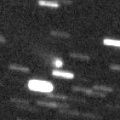
|
It was observed at 16 mag from 2020 to 2021. Now it is fading. It will be fainter than 18 mag in spring.
Date(TT) R.A. (2000) Decl. Delta r Elong. m1 Best Time(A, h)
Feb. 19 15 36.80 -38 15.5 5.851 5.917 89 17.7 5:17 (355, 16)
Feb. 26 15 33.40 -38 59.0 5.762 5.950 96 17.7 5:09 (359, 16)
|

|
Now it is 18.8 mag (Feb. 9, Catalina Sky Survey). In the Northern Hemisphere, it is observable until April when it brightens up to 16 mag. It is not observable in the Southern Hemisphere.
Date(TT) R.A. (2000) Decl. Delta r Elong. m1 Best Time(A, h)
Feb. 19 2 1.37 18 47.2 1.754 1.607 64 18.0 19:10 ( 81, 46)
Feb. 26 2 8.45 18 31.8 1.779 1.533 59 17.9 19:16 ( 85, 41)
|
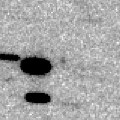
|
Now it is 17.7 mag (Feb. 10, Toshihiko Ikemura, Hirohisa Sato). It will brighten up to 16 mag in 2023. In the Southern Hemisphere, it stays observable in good condition for a long time. In the Northern Hemisphere, it is observable only until May.
Date(TT) R.A. (2000) Decl. Delta r Elong. m1 Best Time(A, h)
Feb. 19 10 19.79 -15 11.4 3.714 4.618 153 18.0 0:26 ( 0, 40)
Feb. 26 10 13.90 -15 36.5 3.659 4.575 154 17.9 23:48 ( 0, 39)
|
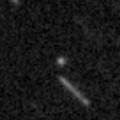
|
First return of a new periodic comet which brightened up to 16.5 mag in 1997. Now it is 17.8 mag (Feb. 7, H. Nohara). It is fainter than originally predicted, but it is brightening rapidly. It is observable in good condition from January to March.
Date(TT) R.A. (2000) Decl. Delta r Elong. m1 Best Time(A, h)
Feb. 19 8 26.94 24 32.4 1.168 2.096 152 18.3 22:30 ( 0, 79)
Feb. 26 8 24.77 23 23.8 1.190 2.083 145 18.2 22:00 ( 0, 78)
|
|
![]()
 C/2021 U5 ( Catalina )
C/2021 U5 ( Catalina ) 132P/Helin-Roman-Alu 2
132P/Helin-Roman-Alu 2 C/2020 S4 ( PanSTARRS )
C/2020 S4 ( PanSTARRS ) C/2020 F7 ( Lemmon )
C/2020 F7 ( Lemmon ) 230P/LINEAR
230P/LINEAR 430P/2021 Q2 ( Scotti )
430P/2021 Q2 ( Scotti ) C/2019 O3 ( Palomar )
C/2019 O3 ( Palomar ) 81P/Wild 2
81P/Wild 2 C/2021 T2 ( Fuls )
C/2021 T2 ( Fuls ) C/2020 U5 ( PanSTARRS )
C/2020 U5 ( PanSTARRS ) C/2020 F2 ( ATLAS )
C/2020 F2 ( ATLAS ) 152P/Helin-Lawrence
152P/Helin-Lawrence 52P/Harrington-Abell
52P/Harrington-Abell 99P/Kowal 1
99P/Kowal 1 C/2021 G2 ( ATLAS )
C/2021 G2 ( ATLAS ) 254P/McNaught
254P/McNaught 274P/Tombaugh-Tenagra
274P/Tombaugh-Tenagra C/2019 T2 ( Lemmon )
C/2019 T2 ( Lemmon ) C/2020 U4 ( PanSTARRS )
C/2020 U4 ( PanSTARRS ) C/2018 N2 ( ASASSN )
C/2018 N2 ( ASASSN ) A/2021 X1
A/2021 X1 C/2021 Y1 ( ATLAS )
C/2021 Y1 ( ATLAS ) C/2021 D2 ( ZTF )
C/2021 D2 ( ZTF ) P/2020 V4 ( Rankin )
P/2020 V4 ( Rankin ) C/2017 Y2 ( PanSTARRS )
C/2017 Y2 ( PanSTARRS ) (3200) Phaethon
(3200) Phaethon C/2021 C5 ( PanSTARRS )
C/2021 C5 ( PanSTARRS ) 440P/2021 W2 ( Kobayashi )
440P/2021 W2 ( Kobayashi )![]()

































































